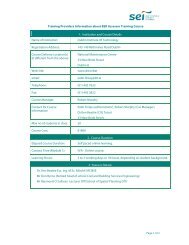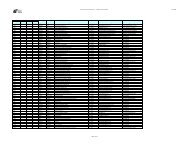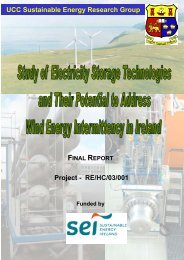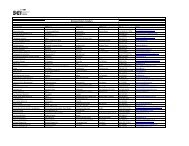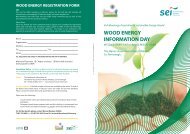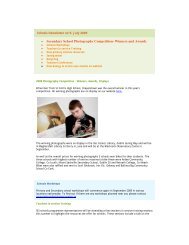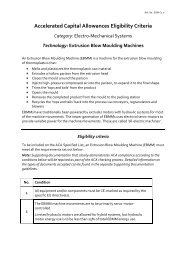Compressors and Condensing Units
Compressors and Condensing Units
Compressors and Condensing Units
Create successful ePaper yourself
Turn your PDF publications into a flip-book with our unique Google optimized e-Paper software.
Accelerated Capital Allowances Eligibility Criteria<br />
Category: Refrigeration <strong>and</strong> Cooling<br />
Technology: <strong>Compressors</strong> <strong>and</strong> <strong>Condensing</strong> <strong>Units</strong><br />
Ref. No.: CCU – C1.1<br />
<strong>Compressors</strong> <strong>and</strong> <strong>Condensing</strong> <strong>Units</strong> are defined as equipment designed to compress<br />
refrigerant vapour, <strong>and</strong> in the case of <strong>Condensing</strong> <strong>Units</strong> to also condense that vapour into a<br />
liquid, achieving very high operational efficiencies.<br />
<strong>Compressors</strong> <strong>and</strong> <strong>Condensing</strong> <strong>Units</strong> equipment is considered to include the following:<br />
<strong>Compressors</strong><br />
Refrigeration compressors are products specifically designed to raise the pressure,<br />
temperature <strong>and</strong> energy level of a refrigerant vapour by mechanical means, as part of a<br />
vapour-compression, economised vapour-compression or transcritical CO 2 refrigeration<br />
cycle.<br />
Economiser packages consist of a refrigeration compressor, an expansion device, <strong>and</strong> an<br />
economiser that is capable of increasing refrigerant sub-cooling <strong>and</strong> refrigeration cycle<br />
efficiency.<br />
<strong>Condensing</strong> <strong>Units</strong><br />
Air-Cooled <strong>Condensing</strong> <strong>Units</strong> products are specifically designed to provide cooling to other<br />
equipment <strong>and</strong> systems that incorporate evaporators (<strong>and</strong> associated expansion valve<br />
control systems). Air-cooled condensing units are factory-assembled units that consist of<br />
one or more compressors, an air-cooled condenser <strong>and</strong> interconnecting pipework. They<br />
may include liquid receivers, filter driers, oil separators, shut-off valves <strong>and</strong> related<br />
controls, <strong>and</strong> a weatherproof housing.<br />
Eligibility criteria<br />
To be included on the ACA Specified List, the specific Refrigeration <strong>and</strong> Cooling equipment<br />
must meet all the relevant requirements set out below.<br />
Note: Supporting documentation that clearly demonstrates ACA compliance according to the<br />
conditions below will be required as part of the ACA checking process. Detailed information<br />
on the types of documents accepted can be found in the separate Supporting Documentation<br />
guidelines.<br />
General eligibility criteria<br />
(applicable to all Refrigeration <strong>and</strong> <strong>Condensing</strong> <strong>Units</strong>)<br />
No.<br />
Condition<br />
1 All equipment <strong>and</strong>/or components must be CE-marked as required by the<br />
specific EU directive(s)<br />
Page 1 of 13
Ref. No.: CCU – C1.1<br />
2 Be designed to operate with one or more clearly identified st<strong>and</strong>ard<br />
refrigerants<br />
3 <strong>Compressors</strong> must be hermetic or semi-hermetic type. Products that<br />
depend on an external motor for compressor operation (i.e. ‘open’-type<br />
compressors) are not eligible<br />
<strong>Compressors</strong> – specific eligibility criteria<br />
(to be met in addition to the general eligibility criteria)<br />
No.<br />
Condition<br />
4 Be either a refrigeration compressor or an economiser package<br />
5 Incorporate a positive displacement type, hermetic or semi-hermetic<br />
compressor (with integral electric motor)<br />
6 Have a displacement greater than 9 cubic metres per hour, except for<br />
products using R744 which must have a displacement greater than 5 cubic<br />
metres per hour<br />
7 Products must have a coefficient of performance (COP) that is greater<br />
than the values shown in Table 1 (below) at the specified rating points.<br />
COP must be calculated according to IS EN 12900:2005 ‘Refrigerant<br />
compressors – Rating conditions, tolerances <strong>and</strong> presentation of<br />
manufacturer’s performance data’.<br />
8 Low-temperature transcritical/subcritical R744 products must include an<br />
appropriately matched gas intercooler that is capable of reducing the<br />
intermediate gas temperature to the level required for second-stage<br />
compression<br />
<strong>Condensing</strong> <strong>Units</strong> – specific eligibility criteria<br />
(to be met in addition to the general eligibility criteria)<br />
No.<br />
Condition<br />
9 Be a factory-assembled unit that incorporates at least the following<br />
components:<br />
a) Air-cooled refrigerant condenser<br />
b) One or more electrically driven refrigeration compressors<br />
c) A control system that controls the product’s compressors <strong>and</strong> cooling<br />
fan(s)<br />
10 Fall into one or more of the following three temperature categories:<br />
High-temperature units<br />
Page 2 of 13
Ref. No.: CCU – C1.1<br />
Medium-temperature units<br />
Low-temperature units<br />
11 Products must have a coefficient of performance (COP) that is greater<br />
than the values shown in Table 2 (below) at the specified rating points<br />
Table 1: Minimum performance thresholds for refrigeration compressors at the Republic<br />
of Irel<strong>and</strong> (RoI) rating points<br />
Category<br />
Evaporating<br />
<strong>Condensing</strong><br />
Compressor<br />
Liquid<br />
COP<br />
temperature<br />
(dew point)<br />
temperature<br />
(dew point)<br />
suction gas<br />
temperature<br />
subcooling<br />
threshold<br />
High-temperature with<br />
HFC 1 or HC 2 refrigerant<br />
Medium-temperature<br />
with HFC or HC<br />
refrigerant<br />
Low-temperature with<br />
HFC or HC refrigerant<br />
Medium-temperature<br />
transcritical/subcritical<br />
with R744 refrigerant<br />
Low-temperature<br />
transcritical/subcritical<br />
with R744 refrigerant<br />
Low-temperature<br />
subcritical with R744<br />
+5°C 35°C 20°C 0K > 5.20<br />
-10°C 30°C 20°C 0K > 3.36<br />
-35°C 25°C 20°C 0K > 1.94<br />
-10°C 15°C 0°C 0K > 4.20<br />
-35°C 15°C -25°C 0K > 1.80<br />
-35°C -5°C -25°C 0K > 3.20<br />
Note: For economiser packages, zero subcooling refers to the liquid condition at the<br />
condenser exit.<br />
Table 2: Performance thresholds for air-cooled condensing units at the RoI rating points<br />
Temperature category<br />
Evaporating<br />
Ambient<br />
Compressor<br />
COP<br />
temperature<br />
(dew point)<br />
(condenser airon)<br />
temperature<br />
suction gas<br />
temperature<br />
threshold<br />
High-temperature units +5°C 20°C 20°C ≥3.9<br />
Medium-temperature<br />
units<br />
-10°C 20°C 20°C ≥2.8<br />
Low-temperature units -35°C 20°C 20°C ≥1.6<br />
1 Hydrofluorocarbon<br />
2 Hydrocarbon<br />
Page 3 of 13
Ref. No.: CCU – C1.1<br />
Where:<br />
COP = refrigerating capacity/power absorbed, including the compressor <strong>and</strong> the condenser<br />
fans (<strong>and</strong> any other power use associated with the air-cooled condensing unit)<br />
The refrigerating capacity <strong>and</strong> power absorbed are as defined in IS EN 13215:2000 –<br />
‘<strong>Condensing</strong> units for refrigeration – Rating conditions, tolerances <strong>and</strong> presentation of<br />
manufacturer’s performance data’, <strong>and</strong> the power absorbed must be measured at full load,<br />
without condenser pressure control, <strong>and</strong> must include the fan power.<br />
Page 4 of 13
---------------------------------- End of ACA eligibility criteria --------------------------------<br />
Ref. No.: CCU– C1.1<br />
Please see next section for guidance on:<br />
1. Technical details required in product submission<br />
2. Supporting documentation required<br />
Guidance on product details <strong>and</strong> supporting documentation<br />
NOTE: The following information is not part of the official criteria document published<br />
within the relevant Statutory Instrument. It has been added here for guidance purposes<br />
only in order to help you to provide (a) product details <strong>and</strong> (b) the required supporting<br />
documentation.<br />
All information contained in this guidance document is subject to change without notice.<br />
Technical information required in product submission<br />
The following are the specific technical values required as part of the product submission<br />
for this technology:<br />
Refrigeration <strong>and</strong> Cooling product type<br />
As part of the product submission you must first select which type of Refrigeration <strong>and</strong><br />
Cooling CCU your product is. Only one type can be chosen per product.<br />
COP<br />
The COP for the product is required as a value for the product submission. It must be<br />
entered as number only without units. There should be no spaces or full stops after the<br />
number submitted. The figure must comply with the criteria requirements for minimum<br />
COP values.<br />
Supporting documentation required<br />
Described below is the list of documents that are accepted as proof of compliance for the<br />
specific Refrigeration <strong>and</strong> Cooling CCU condition.<br />
Note: This information will only be requested AFTER you submit your product’s basic<br />
details online<br />
Important Notes to Product Providers<br />
Please ensure that you read the “Important Notes for Product Providers” section at the<br />
end of this document prior to submitting documentation<br />
Page 5 of 13
Ref. No.: CCU– C1.1<br />
General Conditions<br />
(applicable to all <strong>Compressors</strong> <strong>and</strong> <strong>Condensing</strong> <strong>Units</strong> equipment)<br />
No. Condition Supporting Documentation Requirement<br />
1 All equipment <strong>and</strong>/or components must be CEmarked<br />
as required by the specific EU<br />
directive(s)<br />
Official <strong>and</strong> published manufacturer’s technical data sheet or brochure that<br />
demonstrates CE marking compliance<br />
OR<br />
A copy of an official signed declaration on headed paper that confirms CE marking<br />
compliance.<br />
Official declarations should explicitly state the product for which CE marking is being<br />
confirmed (i.e. do not provide a letter simply stating general compliance with the<br />
relevant ACA condition).<br />
Where a document is used to demonstrate conformance for a number of products or<br />
range of products, it should clearly specify each individual product covered by that<br />
document.<br />
2 Be designed to operate with one or more clearly<br />
identified st<strong>and</strong>ard refrigerants<br />
Official <strong>and</strong> published manufacturer’s technical data sheet or brochure that<br />
demonstrates the requirements of the condition.<br />
3 <strong>Compressors</strong> must be hermetic or semi-hermetic<br />
type. Products that depend on an external<br />
motor for compressor operation (i.e. ‘open’-type<br />
compressors) are not eligible<br />
Official <strong>and</strong> published manufacturer’s technical data sheet or brochure that<br />
demonstrates the requirements of the condition.<br />
Page 6 of 13
Ref. No.: CCU– C1.1<br />
<strong>Compressors</strong> – specific eligibility criteria<br />
(to be met in addition to the general eligibility criteria)<br />
No. Condition Supporting Documentation Requirement<br />
4 Be either a refrigeration compressor or an<br />
economiser package<br />
5 Incorporate a positive displacement type, hermetic<br />
or semi-hermetic compressor (with integral electric<br />
motor)<br />
6 Have a displacement greater than 9 cubic metres per<br />
hour, except for products using R744 which must<br />
have a displacement greater than 5 cubic metres per<br />
hour<br />
7 Products must have a coefficient of performance<br />
(COP) that is greater than the values shown in Table 1<br />
(below) at the specified rating points.<br />
COP must be calculated according to IS EN<br />
12900:2005 ‘Refrigerant compressors – Rating<br />
conditions, tolerances <strong>and</strong> presentation of<br />
manufacturer’s performance data’.<br />
8 Low-temperature transcritical/subcritical R744<br />
products must include an appropriately matched gas<br />
intercooler that is capable of reducing the<br />
intermediate gas temperature to the level required<br />
for second-stage compression<br />
Official <strong>and</strong> published manufacturer’s technical data sheet or brochure that<br />
demonstrates the requirements of the condition.<br />
Official <strong>and</strong> published manufacturer’s technical data sheet or brochure that<br />
demonstrates the requirements of the condition.<br />
Official <strong>and</strong> published manufacturer’s technical data sheet or brochure that<br />
demonstrates the requirements of the condition.<br />
See Supplementary Notes on Testing below<br />
Official <strong>and</strong> published manufacturer’s technical data sheet or brochure that<br />
demonstrates the requirements of the condition.<br />
Page 7 of 13
Ref. No.: CCU– C1.1<br />
<strong>Condensing</strong> <strong>Units</strong> – specific eligibility criteria<br />
(to be met in addition to the general eligibility criteria)<br />
No. Condition Supporting Documentation Requirement<br />
9 Be a factory-assembled unit that incorporates at<br />
least the following components:<br />
a) Air-cooled refrigerant condenser<br />
b) One or more electrically driven refrigeration<br />
compressors<br />
c) A control system that controls the product’s<br />
compressors <strong>and</strong> cooling fan(s)<br />
10 Fall into one or more of the following three<br />
temperature categories:<br />
High-temperature units<br />
Medium-temperature units<br />
Low-temperature units<br />
11 Products must have a coefficient of performance<br />
(COP) that is greater than the values shown in Table<br />
2 (below) at the specified rating points<br />
Official <strong>and</strong> published manufacturer’s technical data sheet or brochure that<br />
demonstrates the requirements of the condition.<br />
Official <strong>and</strong> published manufacturer’s technical data sheet or brochure that<br />
demonstrates the requirements of the condition.<br />
See Supplementary Notes on Testing below<br />
Page 8 of 13
Ref. No.: CCU – C1.1<br />
Supplementary Notes on Testing<br />
All products must be tested in accordance with one of the following st<strong>and</strong>ards:<br />
IS EN 13771-1:2003 ‘Compressor <strong>and</strong> condensing units for refrigeration. Performance<br />
testing <strong>and</strong> test methods. Part 1: Refrigerant compressors’.<br />
ANSI/ASHRAE St<strong>and</strong>ard 23-2005 ‘Methods of Testing for Rating Positive<br />
Displacement Refrigerant <strong>Compressors</strong> <strong>and</strong> <strong>Condensing</strong> <strong>Units</strong>’.<br />
The refrigerant properties used in the analysis of compressor performance must be<br />
obtained from one of the following sources:<br />
The US National Institute of St<strong>and</strong>ards & Technology (NIST) St<strong>and</strong>ard Reference<br />
Database 23 Thermodynamic <strong>and</strong> Transport Properties of Refrigerants <strong>and</strong><br />
Refrigerant Mixtures Database: Version 6.0 or later (see<br />
http://fluidproperties.nist.gov/ or http://www.nist.gov/)<br />
The ASERCOM properties database as defined in the ASERCOM Compressor<br />
Certification scheme, which is based closely on the NIST database (see<br />
http://www.asercom.org/)<br />
For the high-temperature category only, data for a suction gas temperature of 20°C may be<br />
obtained by the thermodynamic translation of data physically tested at 10K superheat.<br />
Where necessary, some liquid sub-cooling may be used during testing to ensure the correct<br />
operation of the test apparatus, provided the results are corrected back to a liquid subcooling<br />
of 0K.<br />
A test report must be submitted in accordance with the formats specified in IS EN 13771-<br />
1:2003. This must include a statement of achieved performance at the required RoI rating<br />
point. For products using HFC or HC, data on refrigerating capacity <strong>and</strong> COP at the<br />
appropriate st<strong>and</strong>ard rating point specified in IS EN 12900:2005 must also be submitted to<br />
enable the test results at the RoI rating point to be cross-checked against the<br />
manufacturer’s published rating data for the product.<br />
If the test report has not been prepared by an independent body, evidence must be<br />
provided that a representative sample of product test data has been independently<br />
verified or cross-checked.<br />
Testing Method A<br />
Under method A, the product’s coefficient of performance (COP) at the relevant RoI rating<br />
point (as specified in Table 2) must be calculated with the method used to generate its<br />
published performance over the st<strong>and</strong>ard range of air temperature <strong>and</strong> evaporating<br />
temperature conditions.<br />
The accuracy of these calculations must be confirmed in the following manner:<br />
a) Actual product performance should be determined at three test<br />
conditions within +/- 1°C of the temperatures in Table 2 by measuring key<br />
parameters in the refrigeration system. The test conditions need not<br />
include the actual st<strong>and</strong>ard RoI rating point.<br />
b) The level of uncertainty (at 95% confidence) in the calculated values for<br />
COP at the relevant RoI rating point must be determined using st<strong>and</strong>ard<br />
statistical methods.<br />
Page 9 of 13
Ref. No.: CCU – C1.1<br />
To be eligible, the product’s COP at the relevant RoI rating point must exceed the<br />
threshold specified in Table 2 by at least the level of uncertainty in the calculations.<br />
The test report must include (or be accompanied by):<br />
a) Details of the calculation method used to determine product performance<br />
b) A copy of the published performance data for the product<br />
c) Manufacturer’s design data for the product <strong>and</strong> its key components, including<br />
type of refrigerant used, condenser fan motor power, <strong>and</strong> product’s compressor<br />
d) The following information on the product’s compressor:<br />
i. Refrigerating capacity <strong>and</strong> COP at the appropriate st<strong>and</strong>ard rating point<br />
specified in IS EN 12900: 2005, <strong>and</strong> at the relevant RoI rating point specified<br />
in the eligibility criteria for ‘refrigeration compressors’<br />
ii.<br />
iii.<br />
Where applicable, evidence that it is listed on the ACA Specified List, or that<br />
its performance has been independently verified<br />
A copy of the manufacturer’s published performance data<br />
e) The following test data, which must be obtained with the product operating<br />
under stable conditions at full load:<br />
i. <strong>Condensing</strong> <strong>and</strong> evaporating pressures <strong>and</strong> dew temperatures at the<br />
compressor inlet <strong>and</strong> outlet<br />
ii.<br />
iii.<br />
Superheat <strong>and</strong> sub-cooling at the compressor’s inlet <strong>and</strong> the unit’s outlet<br />
Condenser air inlet temperature<br />
Testing Method B<br />
Under method B, product performance must be demonstrated by testing the product in<br />
accordance with the following st<strong>and</strong>ard: IS EN 13771-2: 2007 ‘Compressor <strong>and</strong> condensing<br />
units for refrigeration. Performance testing <strong>and</strong> test methods. Part 2: <strong>Condensing</strong> units’.<br />
The refrigerant properties used in the analysis of compressor performance must be<br />
obtained from one of the following sources:<br />
The US National Institute of St<strong>and</strong>ards & Technology (NIST) St<strong>and</strong>ard Reference<br />
Database 23 Thermodynamic <strong>and</strong> Transport Properties of Refrigerants <strong>and</strong><br />
Refrigerant Mixtures Database: Version 6.0 or later (see<br />
http://fluidproperties.nist.gov/ or http://www.nist.gov/)<br />
The ASERCOM properties database as defined in the ASERCOM Compressor<br />
Certification scheme, which is based closely on the NIST database (see<br />
http://www.asercom.org/).<br />
For the high-temperature category only, data for a suction gas temperature of 20°C may be<br />
obtained by the thermodynamic translation of data physically tested at 10K superheat.<br />
A test report must be provided <strong>and</strong> include a statement of achieved performance at the<br />
required RoI rating point. Data on refrigerating capacity <strong>and</strong> COP at the 32°C ambient<br />
temperature st<strong>and</strong>ard reference point specified in IS EN 13215:2000 for air-cooled<br />
condensing units must also be included in the test report to enable the test results at the<br />
RoI rating point to be cross-checked against the manufacturer’s published rating data for<br />
the product.<br />
Page 10 of 13
Ref. No.: CCU – C1.1<br />
Important notes for product providers<br />
General<br />
There should be a clear link between the product submitted <strong>and</strong> all supporting<br />
documentation. This will typically take the form of a product code or product name that can<br />
be cross-referenced between the submitted product <strong>and</strong> the relevant supporting<br />
documentation.<br />
If product codes/names have been changed since publication of the supporting<br />
documentation, then you must provide official evidence of this with the supporting<br />
documentation supplied.<br />
If there is any deviation from these requirements, the supporting documentation will not<br />
be considered adequate for the purposes of demonstrating compliance with the criteria<br />
conditions. This will in turn delay the submission <strong>and</strong>/or result in the product not being<br />
considered eligible.<br />
Where the ACA criteria or help documentation makes reference to compliance with<br />
appropriate rather than specific st<strong>and</strong>ards, the onus is on the product provider to ensure<br />
that the supporting documentation supplied references recognised st<strong>and</strong>ards that apply to<br />
the submitted product, i.e. the product must be covered under the scope of a recognised<br />
st<strong>and</strong>ard.<br />
If it is subsequently found that any product submitted does not meet the performance or<br />
specification criteria, it will cease to be considered eligible for the ACA.<br />
Note: When supplying the supporting documentation through the online process, you<br />
must ensure, when demonstrating compliance with the relevant condition, that the correct<br />
page number(s) of the document is referenced. When referencing more than one page<br />
number, add an explanatory note.<br />
Test report<br />
A test report must include an outline of the complete test, including:<br />
Introduction<br />
Details on test conditions<br />
The specific model details of the product tested<br />
The steps taken in the test<br />
The results<br />
Graphical representations<br />
Conclusion<br />
All documents should be on headed paper <strong>and</strong> the document should be officially signed<br />
off. All documentation must be in English, or include adequate translation.<br />
Certification<br />
Where certificates are provided, all tests must be carried out by an organisation that is<br />
accredited by a national accreditation body, recognised via the European Cooperation for<br />
Accreditation (preferred) or the International Accreditation Forum. All documentation<br />
must be in English, or include adequate translation.<br />
Page 11 of 13
Scientific equivalence<br />
Ref. No.: CCU – C1.1<br />
Some ACA criteria conditions allow for scientifically equivalent tests <strong>and</strong>/or st<strong>and</strong>ards to be<br />
used.<br />
If a product has not been designed, manufactured or tested to the specific st<strong>and</strong>ard<br />
named, then documentation relating to an equivalent internationally recognised st<strong>and</strong>ard<br />
may be used, where the phrase ‘or scientific equivalent’ is included in the ACA condition or<br />
help documentation.<br />
In such applications, the onus is on the product submitter to demonstrate satisfactory<br />
equivalence of the st<strong>and</strong>ards. Submissions which reference such supporting<br />
documentation may take longer to process. If the product provider does not provide<br />
satisfactory evidence of equivalence, then the product will not be considered eligible for<br />
the ACA. All documentation must be in English, or include adequate translation.<br />
Note: Where specific st<strong>and</strong>ards are cited in a condition or in the ACA help documentation,<br />
then documentation demonstrating that the relevant products have been designed,<br />
manufactured or tested to these specific st<strong>and</strong>ards is preferred. Scientific equivalence is<br />
considered the exception rather than the norm.<br />
Representative testing<br />
Where test information is required for a range of technically similar products (e.g.<br />
configurations of one base product), then – in exceptional instances – a form of<br />
representative testing may be used once agreed in advance with SEAI.<br />
Such testing is where only representative products are tested from a technically similar<br />
group or range of products. Representative testing may form an acceptable basis for<br />
supporting documentation if:<br />
A clear correlation can be demonstrated between the tested product <strong>and</strong> a<br />
technically similar non-tested product<br />
<strong>and</strong><br />
Such a correlation clearly demonstrates the compliance of the non-tested product<br />
Note: Where representative testing is used for a group or range of products, if the tested<br />
or representative product is removed from the list of eligible products then all related<br />
products are also removed.<br />
Where applications are being made for a range of two or more products that are variants<br />
of the same basic design, test data may be submitted for a representative selection of<br />
models, provided that all variants:<br />
Use the same refrigerant as the representative model<br />
Have the same compressor type (i.e. manufacturer, method of compression<br />
(e.g. reciprocating or scroll) <strong>and</strong> type of enclosure (e.g. hermetic or semi-hermetic))<br />
as the representative model<br />
Have the same sub-cooling arrangement as the representative model<br />
Fit within the same product category (e.g. are all high-temperature units)<br />
The representative models must be selected by dividing the range of products into groups<br />
of models with similar design characteristics, <strong>and</strong> testing a model in the lowest quartile of<br />
predicted performance in each group. The performance of each model in the group must<br />
be predicted using a validated mathematical model. As a minimum, at least two models<br />
must be tested in each range of products <strong>and</strong> in each laboratory used for product testing.<br />
Page 12 of 13
Ref. No.: CCU – C1.1<br />
Note: If a manufacturer voluntarily removes the representative model from the ACA<br />
Specified List, other products linked with that representative model may or may not be<br />
permitted to remain on the Specified List. If any product submitted under these<br />
representative model rules is later found not to meet the performance criteria when<br />
independently tested, then all products based on the same representative model will be<br />
removed from the Specified List.<br />
Page 13 of 13



